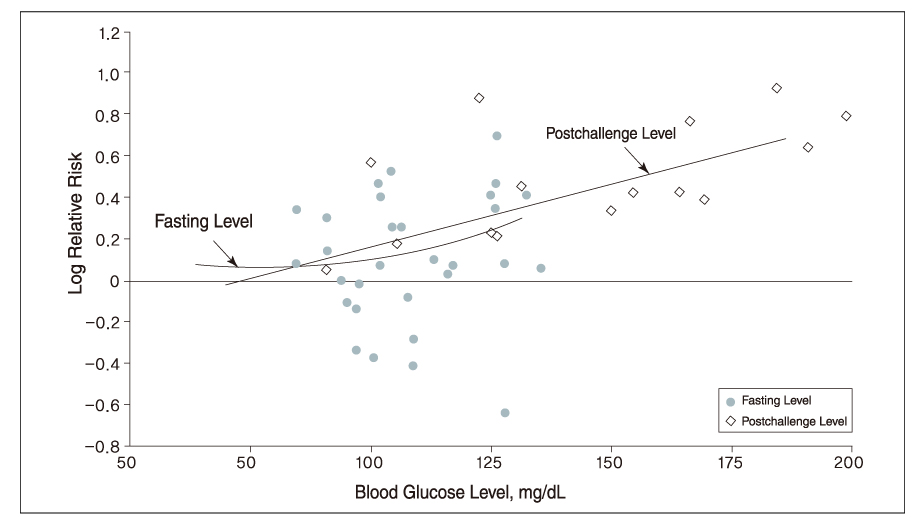J Korean Med Assoc.
2005 Dec;48(12):1173-1178. 10.5124/jkma.2005.48.12.1173.
Clinical Significance of Fasting Glucose Criteria in Metabolic Syndrome
- Affiliations
-
- 1Department of Internal Medicine, Seoul National University College of Medicine and Hospital, Korea. kspark@snu.ac.kr
- KMID: 2015628
- DOI: http://doi.org/10.5124/jkma.2005.48.12.1173
Abstract
- Both Adult Treatment Panel III(ATP III) and International diabetes Federation(IDF) adopted impaired fasting glucose (IFG) as one of the criteria for identifying individuals with metabolic syndrome. However, many studies have shown that IGT is a better predictor of cardiovascular disease(CVD) than IFG. Recently the American Diabetes Association(ADA) revised the diagnostic criteria for IFG, lowering the diagnostic threshold from 110 mg/dL to 100 mg/dL to improve the alignment of IFG and IGT. Although the revised definition of IFG increases the prevalence of metabolic syndrome as well as that of IFG, relative risk of CVD is still lower than that of IGT. The clinical and public health implications of the revised IFG definition remain to be elucidated.
Keyword
Figure
Reference
-
1. Reaven GM. Banting lecture 1988. Role of insulin resistance in human disease. Diabetes. 1988. 37:1595–1607.
Article2. WHO. Definition, diagnosis and classification of diabetes mellitus and its complication. Report of a WHO consultation. 1999.3. National Institutes of Health. NIH publication No. 01 - 3670. Third report of the national cholesterol education program expert panel on detection, evaluation and treatment of high blood cholesterol in adults(Adult Treatment Panel III). Executive summary. 2001.4. Alberti KG, Zimmet P, Shaw J. IDF Epidemiology Task Force Consensus Group. The metabolic syndrome-a new worldwide definition. Lancet. 2005. 366:1059–1062.
Article5. The Expert Committee on the Diagnosis and Classification of Diabetes Mellitus. Report of the Expert Committee on the Diagnosis and Classification of Diabetes Mellitus. Diabetes Care. 1997. 20:Suppl 1. 1183–1197.6. The Expert Committee on the Diagnosis and Classification of Diabetes Mellitus. Report of the Expert Committee on the Diagnosis and Classification of Diabetes Mellitus. Diabetes Care. 2003. 260:Suppl 1. S5–S20.7. DECODE Study Group. the European Diabetes Epidemiology Group. Glucose tolerance and cardiovascular mortality: comparison of fasting and 2-hour diagnostic criteria. Arch Intern Med. 2001. 161:397–405.8. Tominaga M, Eguchi H, Manaka H, Igarashi K, Kato T, Sekikawa A. Impaired glucose tolerance is a risk factor for cardiovascular disease, but not impaired fasting glucose. The Funagata Diabetes Study. Diabetes Care. 1999. 22:920–924.
Article9. Balkau B, Shipley M, Jarrett RJ, Pyorala K, Pyorala M, Eschwege E, et al. High blood glucose concentration is a risk factor for mortality in middle-aged nondiabetic men. 20-year follow-up in the Whitehall Study, the Paris Prospective Study, and the Helsinki Policemen Study. Diabetes Care. 1998. 21:360–367.
Article10. de Vegt F, Dekker JM, Ruhe HG, Stehouwer CD, Nijpels G, Heine RJ, et al. Hyperglycaemia is associated with all-cause and cardiovascular mortality in the Hoorn population: the Hoorn Study. Diabetologia. 1999. 42:926–931.
Article11. Levitan EB, Song Y, Ford ES, Liu S. Is nondiabetic hyperglycemia a risk factor for cardiovascular disease? A meta-analysis of prospective studies. Arch Intern Med. 2004. 164:2147–2155.
Article12. Du X, Matsumura T, Edelstein D, Rossetti L, Zsengeller Z, Brownlee M, et al. Inhibition of GAPDH activity by poly(ADP-ribose) polymerase activates three major pathways of hyperglycemic damage in endothelial cells. J Clin Invest. 2003. 112:1049–1057.
Article13. Schmidt AM, Yan SD, Wautier JL, Stern D. Activation of receptor for advanced glycation end products: a mechanism for chronic vascular dysfunction in diabetic vasculopathy and atherosclerosis. Circ Res. 1999. 84:489–497.14. Fonseca V, Desouza C, Asnani S, Jialal I. Nontraditional risk factors for cardiovascular disease in diabetes. Endocr Rev. 2004. 25:153–175.
Article15. Tai ES, Goh SY, Lee JJ, Wong MS, Heng D, Tan CE, et al. Lowering the criterion for impaired fasting glucose: impact on disease prevalence and associated risk of diabetes and ischemic heart disease. Diabetes Care. 2004. 27:1728–1734.16. Borch-Johnsen K, Colagiuri S, Balkau B, Glumer C, Carstensen B, Gao W, et al. Creating a pandemic of prediabetes: the proposed new diagnostic criteria for impaired fasting glycaemia. Diabetologia. 2004. 47:1396–1402.
Article17. Ford ES, Abbasi F, Reaven GM. Prevalence of insulin resistance and the metabolic syndrome with alternative definitions of impaired fasting glucose. Atherosclerosis. 2005. 181:143–148.
Article18. Kahn R, Buse J, Ferrannini E, Stern M. The metabolic syndrome: time for a critical appraisal: joint statement from the American Diabetes Association and the European Association for the Study of Diabetes. Diabetes Care. 2005. 28:2289–2304.
Article
- Full Text Links
- Actions
-
Cited
- CITED
-
- Close
- Share
- Similar articles
-
- Prevalence of the Metabolic Syndrome among Outpatients with Schizophrenia or Schizoaffective Disorder
- The Relationship between High Sensitivity C-Reactive Protein and Metabolic Syndrome according to the Fasting Glucose Level at Medical Checkups
- Prevalence of Metabolic Syndrome according to the New Criteria for Obesity
- The Prevalence of Metabolic Syndrome according to the Degree of Glucose Metabolism Impairment
- Fasting Plasma Glucose Levels and Metabolic Syndrome in Normoglycemic Adults


